Corporate Social Responsibility: Motivations, Strategies, and Examples
VerifiedAdded on 2023/01/20
|11
|2558
|87
Report
AI Summary
This report delves into the concept of Corporate Social Responsibility (CSR), defining it as a business model that emphasizes social accountability to customers, stakeholders, and the broader community. It explores the motivations behind adopting CSR strategies, including economic and ethical considerations, learning and innovation, employee motivation, and risk management. The report examines the role and objectives of CSR, such as integrating long-term economic, environmental, and social aspects, mitigating stakeholder demands, and fostering innovation. Real-world examples of CSR implementation in India, including initiatives by the Tata Group, Ultratech Cement, Mahindra & Mahindra, and the ITC Group, are highlighted. The report concludes with recommendations for companies, emphasizing the importance of forecasting CSR impacts, considering supplier interests, prioritizing environmental benefits, focusing on underprivileged communities, and addressing employee conditions. Overall, the report underscores CSR as a crucial component of business sustainability and a means of creating positive societal impacts.
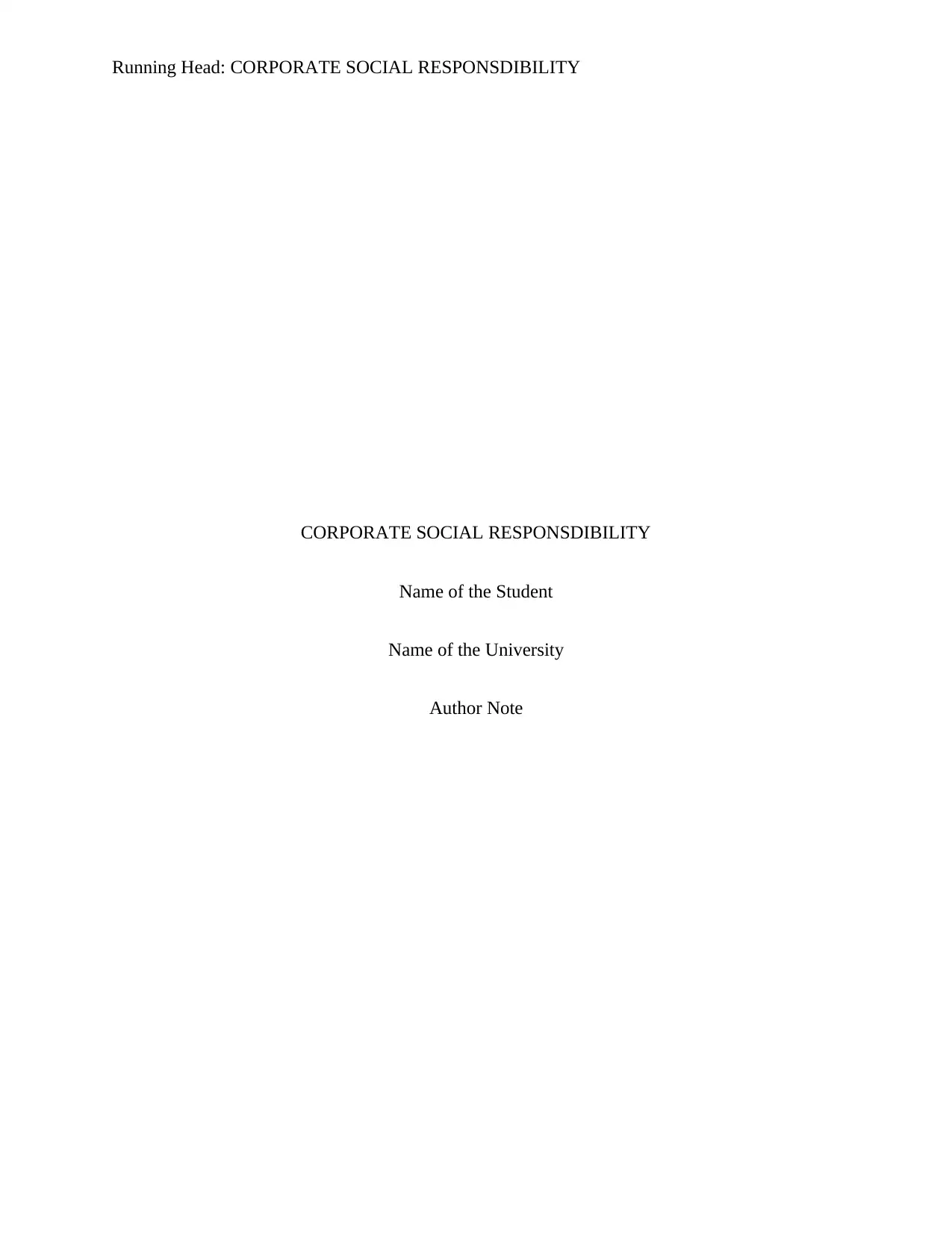
Running Head: CORPORATE SOCIAL RESPONSDIBILITY
CORPORATE SOCIAL RESPONSDIBILITY
Name of the Student
Name of the University
Author Note
CORPORATE SOCIAL RESPONSDIBILITY
Name of the Student
Name of the University
Author Note
Paraphrase This Document
Need a fresh take? Get an instant paraphrase of this document with our AI Paraphraser
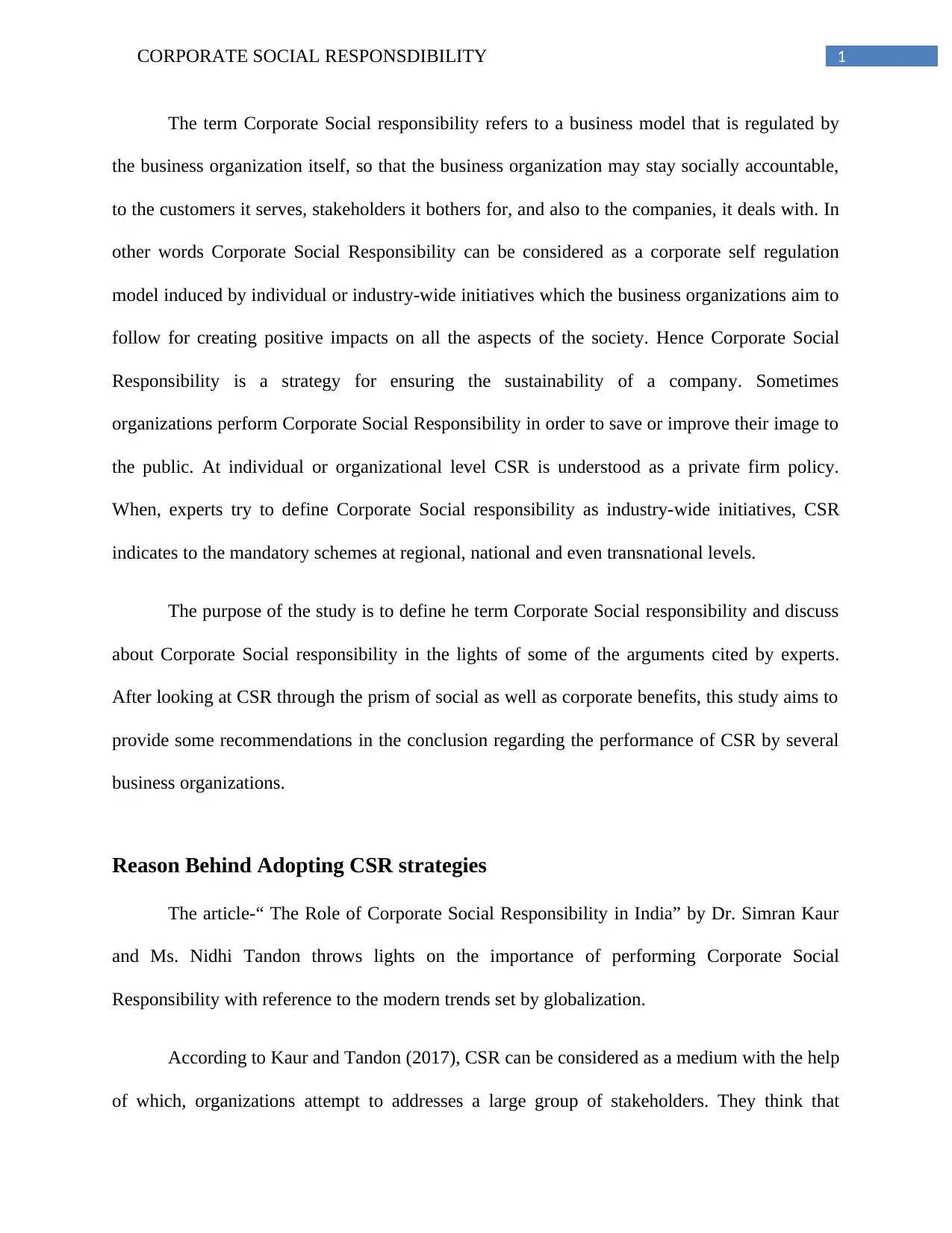
1CORPORATE SOCIAL RESPONSDIBILITY
The term Corporate Social responsibility refers to a business model that is regulated by
the business organization itself, so that the business organization may stay socially accountable,
to the customers it serves, stakeholders it bothers for, and also to the companies, it deals with. In
other words Corporate Social Responsibility can be considered as a corporate self regulation
model induced by individual or industry-wide initiatives which the business organizations aim to
follow for creating positive impacts on all the aspects of the society. Hence Corporate Social
Responsibility is a strategy for ensuring the sustainability of a company. Sometimes
organizations perform Corporate Social Responsibility in order to save or improve their image to
the public. At individual or organizational level CSR is understood as a private firm policy.
When, experts try to define Corporate Social responsibility as industry-wide initiatives, CSR
indicates to the mandatory schemes at regional, national and even transnational levels.
The purpose of the study is to define he term Corporate Social responsibility and discuss
about Corporate Social responsibility in the lights of some of the arguments cited by experts.
After looking at CSR through the prism of social as well as corporate benefits, this study aims to
provide some recommendations in the conclusion regarding the performance of CSR by several
business organizations.
Reason Behind Adopting CSR strategies
The article-“ The Role of Corporate Social Responsibility in India” by Dr. Simran Kaur
and Ms. Nidhi Tandon throws lights on the importance of performing Corporate Social
Responsibility with reference to the modern trends set by globalization.
According to Kaur and Tandon (2017), CSR can be considered as a medium with the help
of which, organizations attempt to addresses a large group of stakeholders. They think that
The term Corporate Social responsibility refers to a business model that is regulated by
the business organization itself, so that the business organization may stay socially accountable,
to the customers it serves, stakeholders it bothers for, and also to the companies, it deals with. In
other words Corporate Social Responsibility can be considered as a corporate self regulation
model induced by individual or industry-wide initiatives which the business organizations aim to
follow for creating positive impacts on all the aspects of the society. Hence Corporate Social
Responsibility is a strategy for ensuring the sustainability of a company. Sometimes
organizations perform Corporate Social Responsibility in order to save or improve their image to
the public. At individual or organizational level CSR is understood as a private firm policy.
When, experts try to define Corporate Social responsibility as industry-wide initiatives, CSR
indicates to the mandatory schemes at regional, national and even transnational levels.
The purpose of the study is to define he term Corporate Social responsibility and discuss
about Corporate Social responsibility in the lights of some of the arguments cited by experts.
After looking at CSR through the prism of social as well as corporate benefits, this study aims to
provide some recommendations in the conclusion regarding the performance of CSR by several
business organizations.
Reason Behind Adopting CSR strategies
The article-“ The Role of Corporate Social Responsibility in India” by Dr. Simran Kaur
and Ms. Nidhi Tandon throws lights on the importance of performing Corporate Social
Responsibility with reference to the modern trends set by globalization.
According to Kaur and Tandon (2017), CSR can be considered as a medium with the help
of which, organizations attempt to addresses a large group of stakeholders. They think that
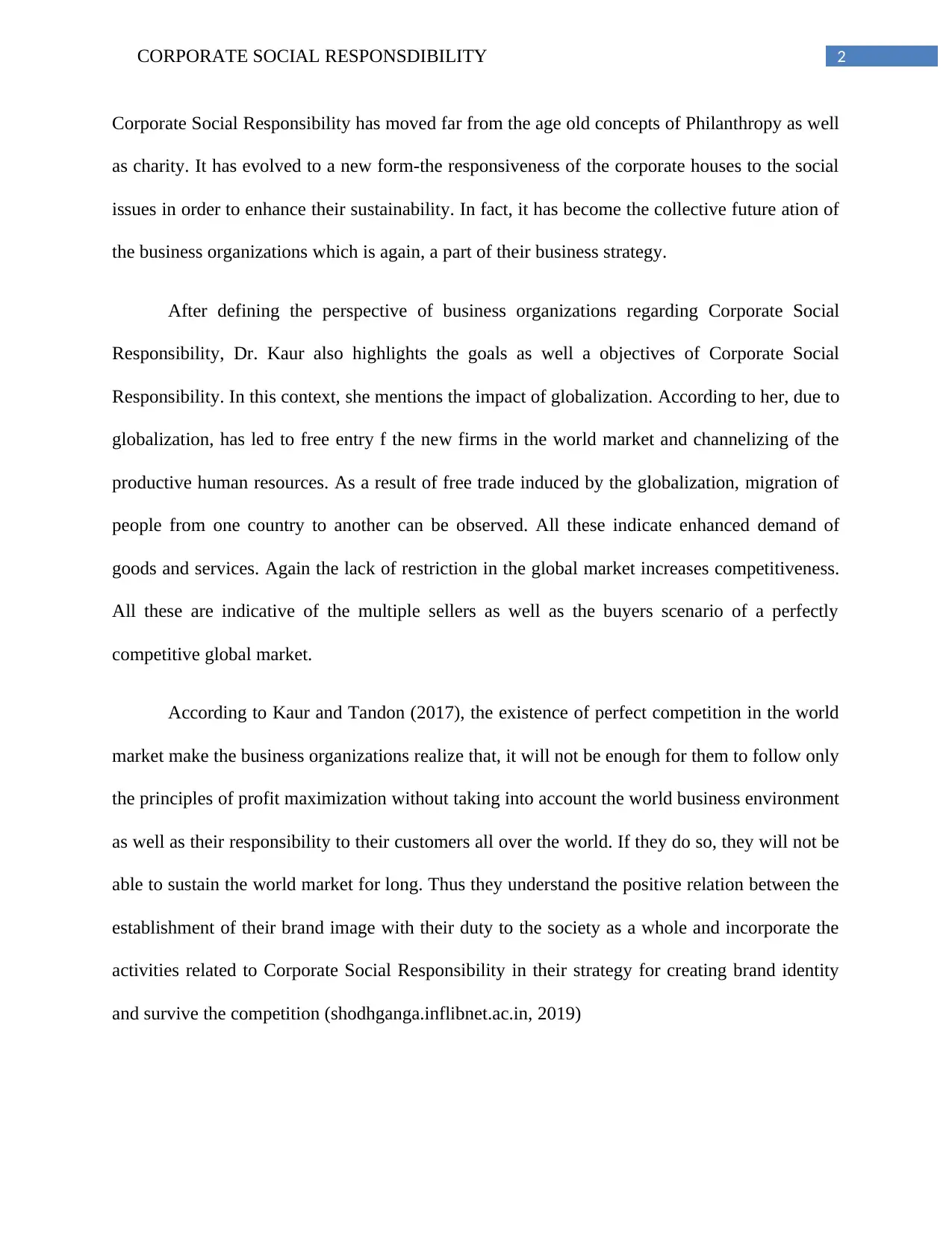
2CORPORATE SOCIAL RESPONSDIBILITY
Corporate Social Responsibility has moved far from the age old concepts of Philanthropy as well
as charity. It has evolved to a new form-the responsiveness of the corporate houses to the social
issues in order to enhance their sustainability. In fact, it has become the collective future ation of
the business organizations which is again, a part of their business strategy.
After defining the perspective of business organizations regarding Corporate Social
Responsibility, Dr. Kaur also highlights the goals as well a objectives of Corporate Social
Responsibility. In this context, she mentions the impact of globalization. According to her, due to
globalization, has led to free entry f the new firms in the world market and channelizing of the
productive human resources. As a result of free trade induced by the globalization, migration of
people from one country to another can be observed. All these indicate enhanced demand of
goods and services. Again the lack of restriction in the global market increases competitiveness.
All these are indicative of the multiple sellers as well as the buyers scenario of a perfectly
competitive global market.
According to Kaur and Tandon (2017), the existence of perfect competition in the world
market make the business organizations realize that, it will not be enough for them to follow only
the principles of profit maximization without taking into account the world business environment
as well as their responsibility to their customers all over the world. If they do so, they will not be
able to sustain the world market for long. Thus they understand the positive relation between the
establishment of their brand image with their duty to the society as a whole and incorporate the
activities related to Corporate Social Responsibility in their strategy for creating brand identity
and survive the competition (shodhganga.inflibnet.ac.in, 2019)
Corporate Social Responsibility has moved far from the age old concepts of Philanthropy as well
as charity. It has evolved to a new form-the responsiveness of the corporate houses to the social
issues in order to enhance their sustainability. In fact, it has become the collective future ation of
the business organizations which is again, a part of their business strategy.
After defining the perspective of business organizations regarding Corporate Social
Responsibility, Dr. Kaur also highlights the goals as well a objectives of Corporate Social
Responsibility. In this context, she mentions the impact of globalization. According to her, due to
globalization, has led to free entry f the new firms in the world market and channelizing of the
productive human resources. As a result of free trade induced by the globalization, migration of
people from one country to another can be observed. All these indicate enhanced demand of
goods and services. Again the lack of restriction in the global market increases competitiveness.
All these are indicative of the multiple sellers as well as the buyers scenario of a perfectly
competitive global market.
According to Kaur and Tandon (2017), the existence of perfect competition in the world
market make the business organizations realize that, it will not be enough for them to follow only
the principles of profit maximization without taking into account the world business environment
as well as their responsibility to their customers all over the world. If they do so, they will not be
able to sustain the world market for long. Thus they understand the positive relation between the
establishment of their brand image with their duty to the society as a whole and incorporate the
activities related to Corporate Social Responsibility in their strategy for creating brand identity
and survive the competition (shodhganga.inflibnet.ac.in, 2019)
⊘ This is a preview!⊘
Do you want full access?
Subscribe today to unlock all pages.

Trusted by 1+ million students worldwide
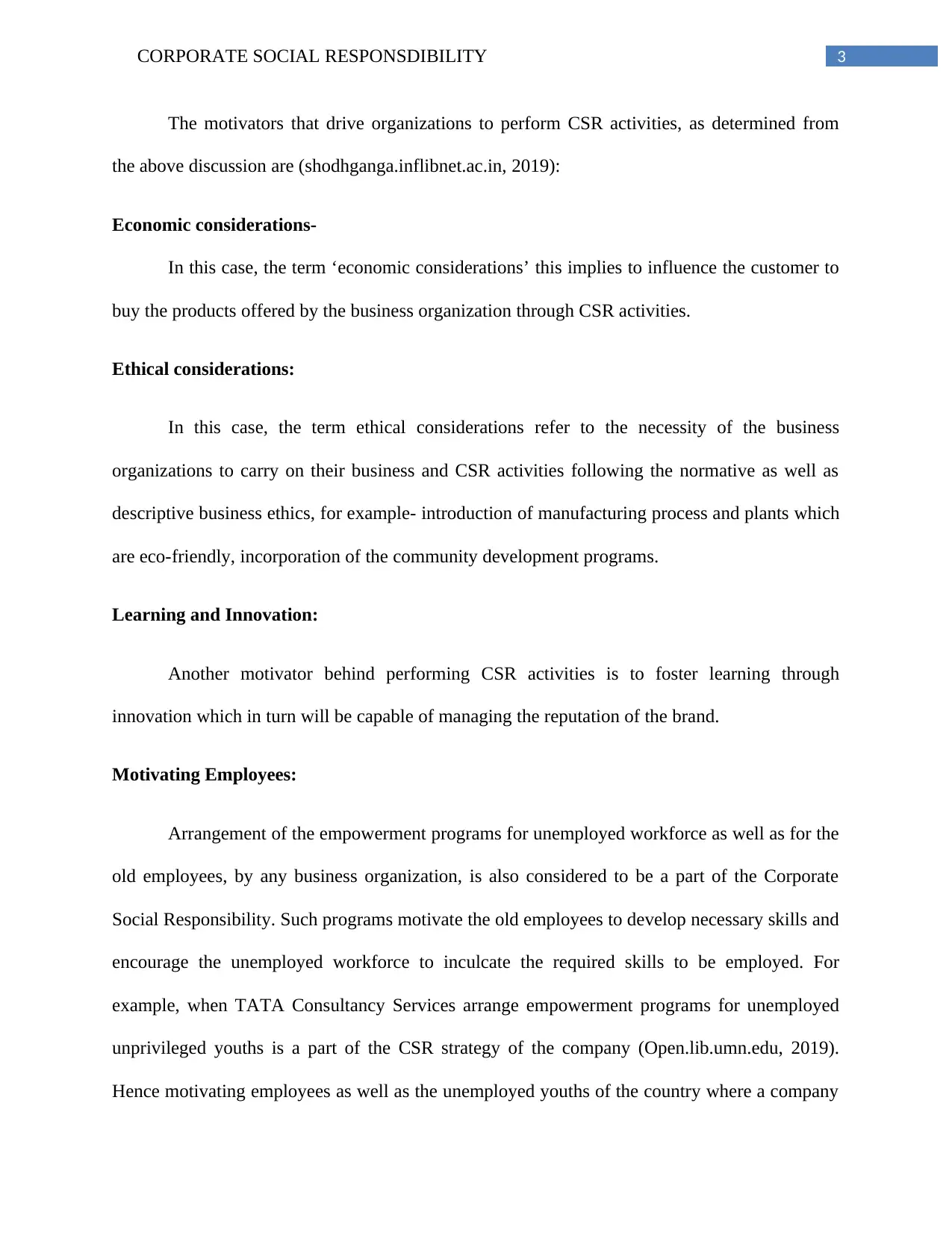
3CORPORATE SOCIAL RESPONSDIBILITY
The motivators that drive organizations to perform CSR activities, as determined from
the above discussion are (shodhganga.inflibnet.ac.in, 2019):
Economic considerations-
In this case, the term ‘economic considerations’ this implies to influence the customer to
buy the products offered by the business organization through CSR activities.
Ethical considerations:
In this case, the term ethical considerations refer to the necessity of the business
organizations to carry on their business and CSR activities following the normative as well as
descriptive business ethics, for example- introduction of manufacturing process and plants which
are eco-friendly, incorporation of the community development programs.
Learning and Innovation:
Another motivator behind performing CSR activities is to foster learning through
innovation which in turn will be capable of managing the reputation of the brand.
Motivating Employees:
Arrangement of the empowerment programs for unemployed workforce as well as for the
old employees, by any business organization, is also considered to be a part of the Corporate
Social Responsibility. Such programs motivate the old employees to develop necessary skills and
encourage the unemployed workforce to inculcate the required skills to be employed. For
example, when TATA Consultancy Services arrange empowerment programs for unemployed
unprivileged youths is a part of the CSR strategy of the company (Open.lib.umn.edu, 2019).
Hence motivating employees as well as the unemployed youths of the country where a company
The motivators that drive organizations to perform CSR activities, as determined from
the above discussion are (shodhganga.inflibnet.ac.in, 2019):
Economic considerations-
In this case, the term ‘economic considerations’ this implies to influence the customer to
buy the products offered by the business organization through CSR activities.
Ethical considerations:
In this case, the term ethical considerations refer to the necessity of the business
organizations to carry on their business and CSR activities following the normative as well as
descriptive business ethics, for example- introduction of manufacturing process and plants which
are eco-friendly, incorporation of the community development programs.
Learning and Innovation:
Another motivator behind performing CSR activities is to foster learning through
innovation which in turn will be capable of managing the reputation of the brand.
Motivating Employees:
Arrangement of the empowerment programs for unemployed workforce as well as for the
old employees, by any business organization, is also considered to be a part of the Corporate
Social Responsibility. Such programs motivate the old employees to develop necessary skills and
encourage the unemployed workforce to inculcate the required skills to be employed. For
example, when TATA Consultancy Services arrange empowerment programs for unemployed
unprivileged youths is a part of the CSR strategy of the company (Open.lib.umn.edu, 2019).
Hence motivating employees as well as the unemployed youths of the country where a company
Paraphrase This Document
Need a fresh take? Get an instant paraphrase of this document with our AI Paraphraser
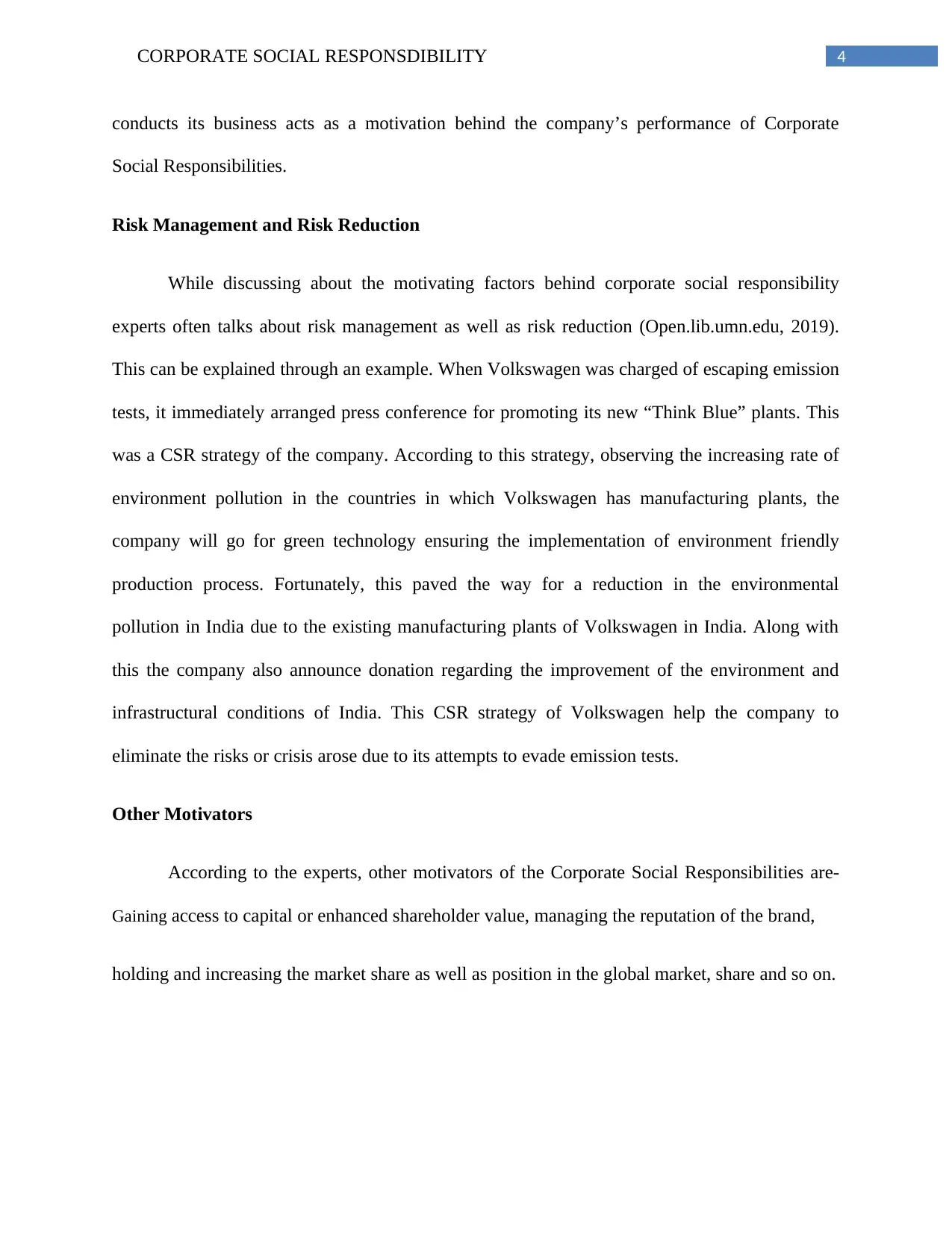
4CORPORATE SOCIAL RESPONSDIBILITY
conducts its business acts as a motivation behind the company’s performance of Corporate
Social Responsibilities.
Risk Management and Risk Reduction
While discussing about the motivating factors behind corporate social responsibility
experts often talks about risk management as well as risk reduction (Open.lib.umn.edu, 2019).
This can be explained through an example. When Volkswagen was charged of escaping emission
tests, it immediately arranged press conference for promoting its new “Think Blue” plants. This
was a CSR strategy of the company. According to this strategy, observing the increasing rate of
environment pollution in the countries in which Volkswagen has manufacturing plants, the
company will go for green technology ensuring the implementation of environment friendly
production process. Fortunately, this paved the way for a reduction in the environmental
pollution in India due to the existing manufacturing plants of Volkswagen in India. Along with
this the company also announce donation regarding the improvement of the environment and
infrastructural conditions of India. This CSR strategy of Volkswagen help the company to
eliminate the risks or crisis arose due to its attempts to evade emission tests.
Other Motivators
According to the experts, other motivators of the Corporate Social Responsibilities are-
Gaining access to capital or enhanced shareholder value, managing the reputation of the brand,
holding and increasing the market share as well as position in the global market, share and so on.
conducts its business acts as a motivation behind the company’s performance of Corporate
Social Responsibilities.
Risk Management and Risk Reduction
While discussing about the motivating factors behind corporate social responsibility
experts often talks about risk management as well as risk reduction (Open.lib.umn.edu, 2019).
This can be explained through an example. When Volkswagen was charged of escaping emission
tests, it immediately arranged press conference for promoting its new “Think Blue” plants. This
was a CSR strategy of the company. According to this strategy, observing the increasing rate of
environment pollution in the countries in which Volkswagen has manufacturing plants, the
company will go for green technology ensuring the implementation of environment friendly
production process. Fortunately, this paved the way for a reduction in the environmental
pollution in India due to the existing manufacturing plants of Volkswagen in India. Along with
this the company also announce donation regarding the improvement of the environment and
infrastructural conditions of India. This CSR strategy of Volkswagen help the company to
eliminate the risks or crisis arose due to its attempts to evade emission tests.
Other Motivators
According to the experts, other motivators of the Corporate Social Responsibilities are-
Gaining access to capital or enhanced shareholder value, managing the reputation of the brand,
holding and increasing the market share as well as position in the global market, share and so on.
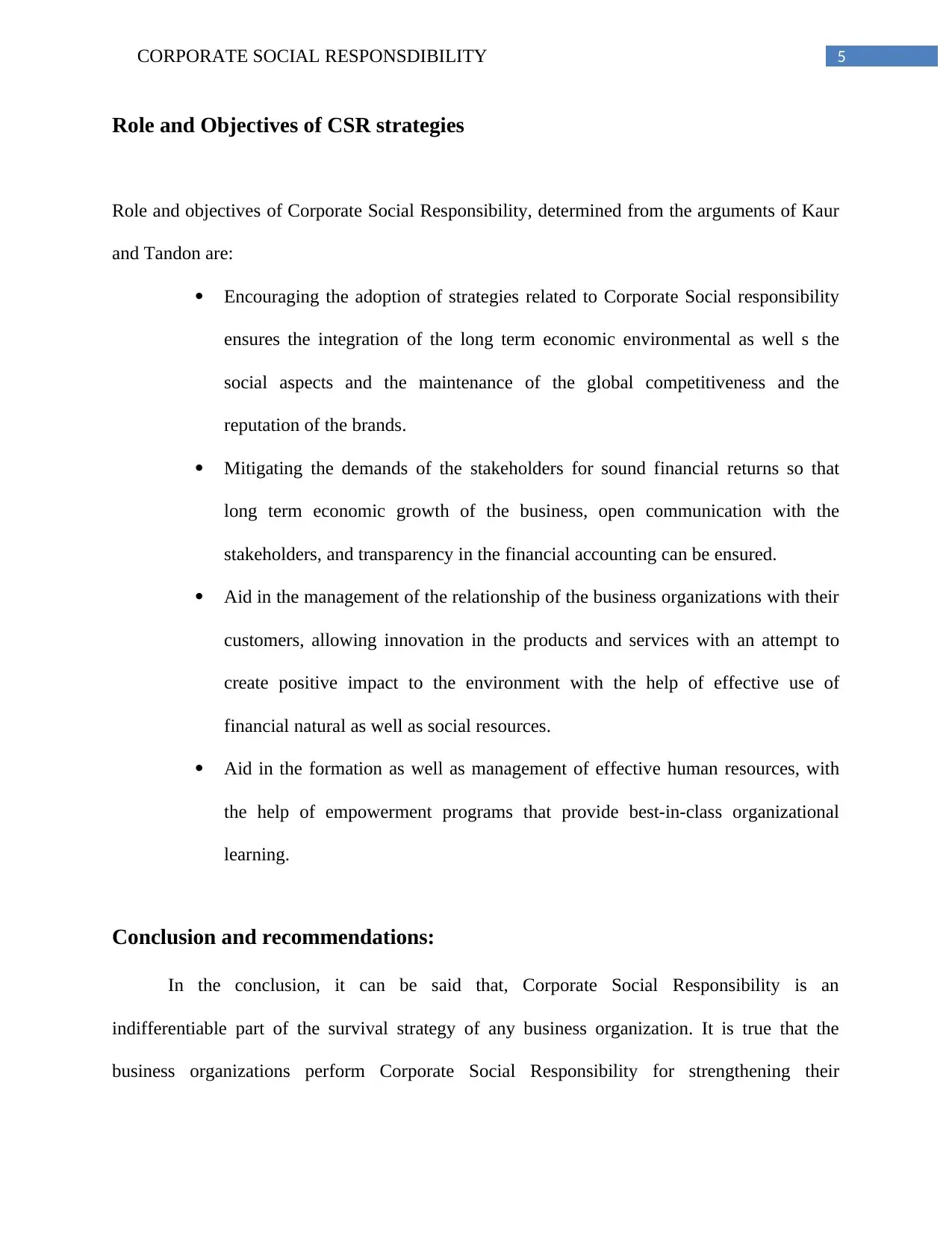
5CORPORATE SOCIAL RESPONSDIBILITY
Role and Objectives of CSR strategies
Role and objectives of Corporate Social Responsibility, determined from the arguments of Kaur
and Tandon are:
Encouraging the adoption of strategies related to Corporate Social responsibility
ensures the integration of the long term economic environmental as well s the
social aspects and the maintenance of the global competitiveness and the
reputation of the brands.
Mitigating the demands of the stakeholders for sound financial returns so that
long term economic growth of the business, open communication with the
stakeholders, and transparency in the financial accounting can be ensured.
Aid in the management of the relationship of the business organizations with their
customers, allowing innovation in the products and services with an attempt to
create positive impact to the environment with the help of effective use of
financial natural as well as social resources.
Aid in the formation as well as management of effective human resources, with
the help of empowerment programs that provide best-in-class organizational
learning.
Conclusion and recommendations:
In the conclusion, it can be said that, Corporate Social Responsibility is an
indifferentiable part of the survival strategy of any business organization. It is true that the
business organizations perform Corporate Social Responsibility for strengthening their
Role and Objectives of CSR strategies
Role and objectives of Corporate Social Responsibility, determined from the arguments of Kaur
and Tandon are:
Encouraging the adoption of strategies related to Corporate Social responsibility
ensures the integration of the long term economic environmental as well s the
social aspects and the maintenance of the global competitiveness and the
reputation of the brands.
Mitigating the demands of the stakeholders for sound financial returns so that
long term economic growth of the business, open communication with the
stakeholders, and transparency in the financial accounting can be ensured.
Aid in the management of the relationship of the business organizations with their
customers, allowing innovation in the products and services with an attempt to
create positive impact to the environment with the help of effective use of
financial natural as well as social resources.
Aid in the formation as well as management of effective human resources, with
the help of empowerment programs that provide best-in-class organizational
learning.
Conclusion and recommendations:
In the conclusion, it can be said that, Corporate Social Responsibility is an
indifferentiable part of the survival strategy of any business organization. It is true that the
business organizations perform Corporate Social Responsibility for strengthening their
⊘ This is a preview!⊘
Do you want full access?
Subscribe today to unlock all pages.

Trusted by 1+ million students worldwide
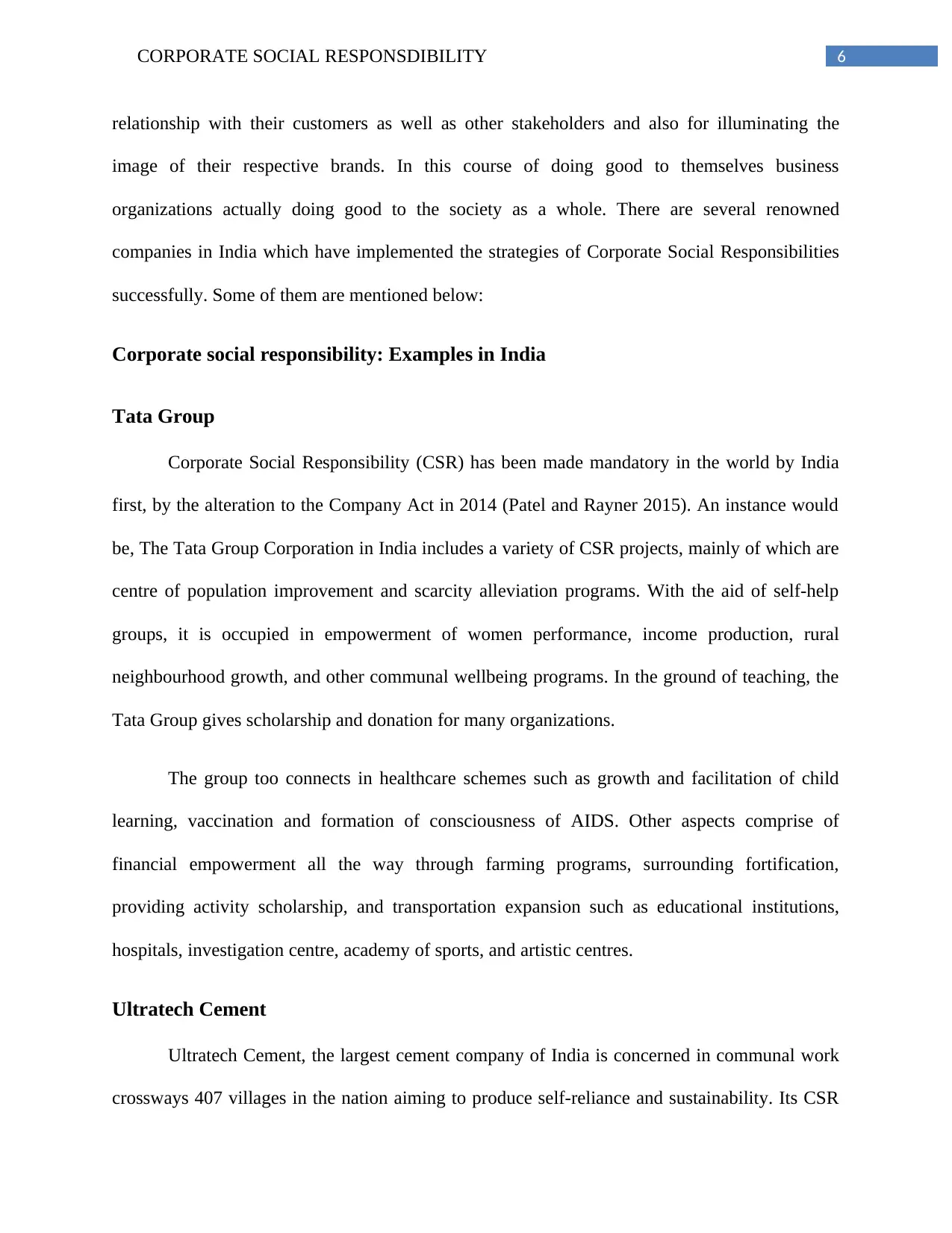
6CORPORATE SOCIAL RESPONSDIBILITY
relationship with their customers as well as other stakeholders and also for illuminating the
image of their respective brands. In this course of doing good to themselves business
organizations actually doing good to the society as a whole. There are several renowned
companies in India which have implemented the strategies of Corporate Social Responsibilities
successfully. Some of them are mentioned below:
Corporate social responsibility: Examples in India
Tata Group
Corporate Social Responsibility (CSR) has been made mandatory in the world by India
first, by the alteration to the Company Act in 2014 (Patel and Rayner 2015). An instance would
be, The Tata Group Corporation in India includes a variety of CSR projects, mainly of which are
centre of population improvement and scarcity alleviation programs. With the aid of self-help
groups, it is occupied in empowerment of women performance, income production, rural
neighbourhood growth, and other communal wellbeing programs. In the ground of teaching, the
Tata Group gives scholarship and donation for many organizations.
The group too connects in healthcare schemes such as growth and facilitation of child
learning, vaccination and formation of consciousness of AIDS. Other aspects comprise of
financial empowerment all the way through farming programs, surrounding fortification,
providing activity scholarship, and transportation expansion such as educational institutions,
hospitals, investigation centre, academy of sports, and artistic centres.
Ultratech Cement
Ultratech Cement, the largest cement company of India is concerned in communal work
crossways 407 villages in the nation aiming to produce self-reliance and sustainability. Its CSR
relationship with their customers as well as other stakeholders and also for illuminating the
image of their respective brands. In this course of doing good to themselves business
organizations actually doing good to the society as a whole. There are several renowned
companies in India which have implemented the strategies of Corporate Social Responsibilities
successfully. Some of them are mentioned below:
Corporate social responsibility: Examples in India
Tata Group
Corporate Social Responsibility (CSR) has been made mandatory in the world by India
first, by the alteration to the Company Act in 2014 (Patel and Rayner 2015). An instance would
be, The Tata Group Corporation in India includes a variety of CSR projects, mainly of which are
centre of population improvement and scarcity alleviation programs. With the aid of self-help
groups, it is occupied in empowerment of women performance, income production, rural
neighbourhood growth, and other communal wellbeing programs. In the ground of teaching, the
Tata Group gives scholarship and donation for many organizations.
The group too connects in healthcare schemes such as growth and facilitation of child
learning, vaccination and formation of consciousness of AIDS. Other aspects comprise of
financial empowerment all the way through farming programs, surrounding fortification,
providing activity scholarship, and transportation expansion such as educational institutions,
hospitals, investigation centre, academy of sports, and artistic centres.
Ultratech Cement
Ultratech Cement, the largest cement company of India is concerned in communal work
crossways 407 villages in the nation aiming to produce self-reliance and sustainability. Its CSR
Paraphrase This Document
Need a fresh take? Get an instant paraphrase of this document with our AI Paraphraser
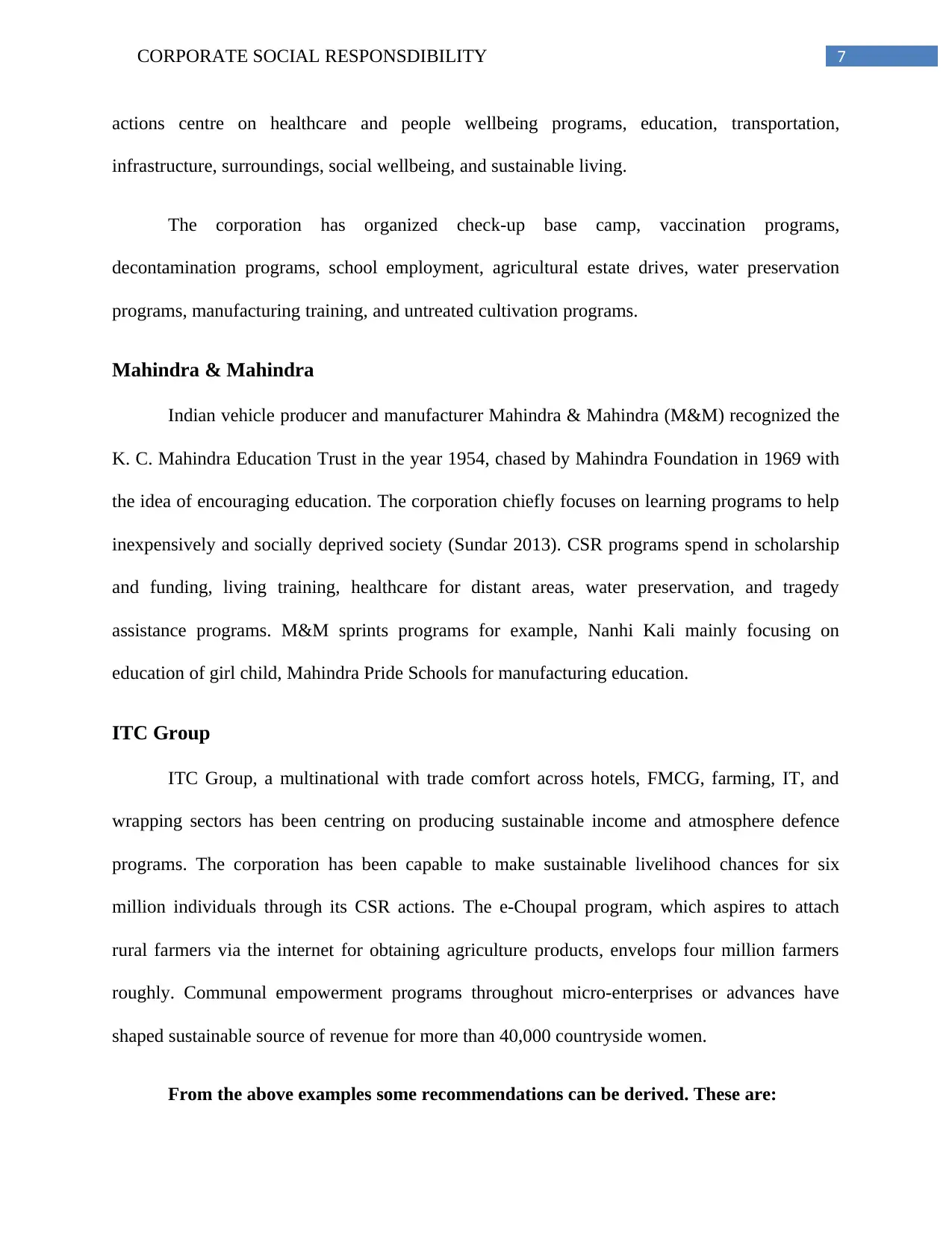
7CORPORATE SOCIAL RESPONSDIBILITY
actions centre on healthcare and people wellbeing programs, education, transportation,
infrastructure, surroundings, social wellbeing, and sustainable living.
The corporation has organized check-up base camp, vaccination programs,
decontamination programs, school employment, agricultural estate drives, water preservation
programs, manufacturing training, and untreated cultivation programs.
Mahindra & Mahindra
Indian vehicle producer and manufacturer Mahindra & Mahindra (M&M) recognized the
K. C. Mahindra Education Trust in the year 1954, chased by Mahindra Foundation in 1969 with
the idea of encouraging education. The corporation chiefly focuses on learning programs to help
inexpensively and socially deprived society (Sundar 2013). CSR programs spend in scholarship
and funding, living training, healthcare for distant areas, water preservation, and tragedy
assistance programs. M&M sprints programs for example, Nanhi Kali mainly focusing on
education of girl child, Mahindra Pride Schools for manufacturing education.
ITC Group
ITC Group, a multinational with trade comfort across hotels, FMCG, farming, IT, and
wrapping sectors has been centring on producing sustainable income and atmosphere defence
programs. The corporation has been capable to make sustainable livelihood chances for six
million individuals through its CSR actions. The e-Choupal program, which aspires to attach
rural farmers via the internet for obtaining agriculture products, envelops four million farmers
roughly. Communal empowerment programs throughout micro-enterprises or advances have
shaped sustainable source of revenue for more than 40,000 countryside women.
From the above examples some recommendations can be derived. These are:
actions centre on healthcare and people wellbeing programs, education, transportation,
infrastructure, surroundings, social wellbeing, and sustainable living.
The corporation has organized check-up base camp, vaccination programs,
decontamination programs, school employment, agricultural estate drives, water preservation
programs, manufacturing training, and untreated cultivation programs.
Mahindra & Mahindra
Indian vehicle producer and manufacturer Mahindra & Mahindra (M&M) recognized the
K. C. Mahindra Education Trust in the year 1954, chased by Mahindra Foundation in 1969 with
the idea of encouraging education. The corporation chiefly focuses on learning programs to help
inexpensively and socially deprived society (Sundar 2013). CSR programs spend in scholarship
and funding, living training, healthcare for distant areas, water preservation, and tragedy
assistance programs. M&M sprints programs for example, Nanhi Kali mainly focusing on
education of girl child, Mahindra Pride Schools for manufacturing education.
ITC Group
ITC Group, a multinational with trade comfort across hotels, FMCG, farming, IT, and
wrapping sectors has been centring on producing sustainable income and atmosphere defence
programs. The corporation has been capable to make sustainable livelihood chances for six
million individuals through its CSR actions. The e-Choupal program, which aspires to attach
rural farmers via the internet for obtaining agriculture products, envelops four million farmers
roughly. Communal empowerment programs throughout micro-enterprises or advances have
shaped sustainable source of revenue for more than 40,000 countryside women.
From the above examples some recommendations can be derived. These are:
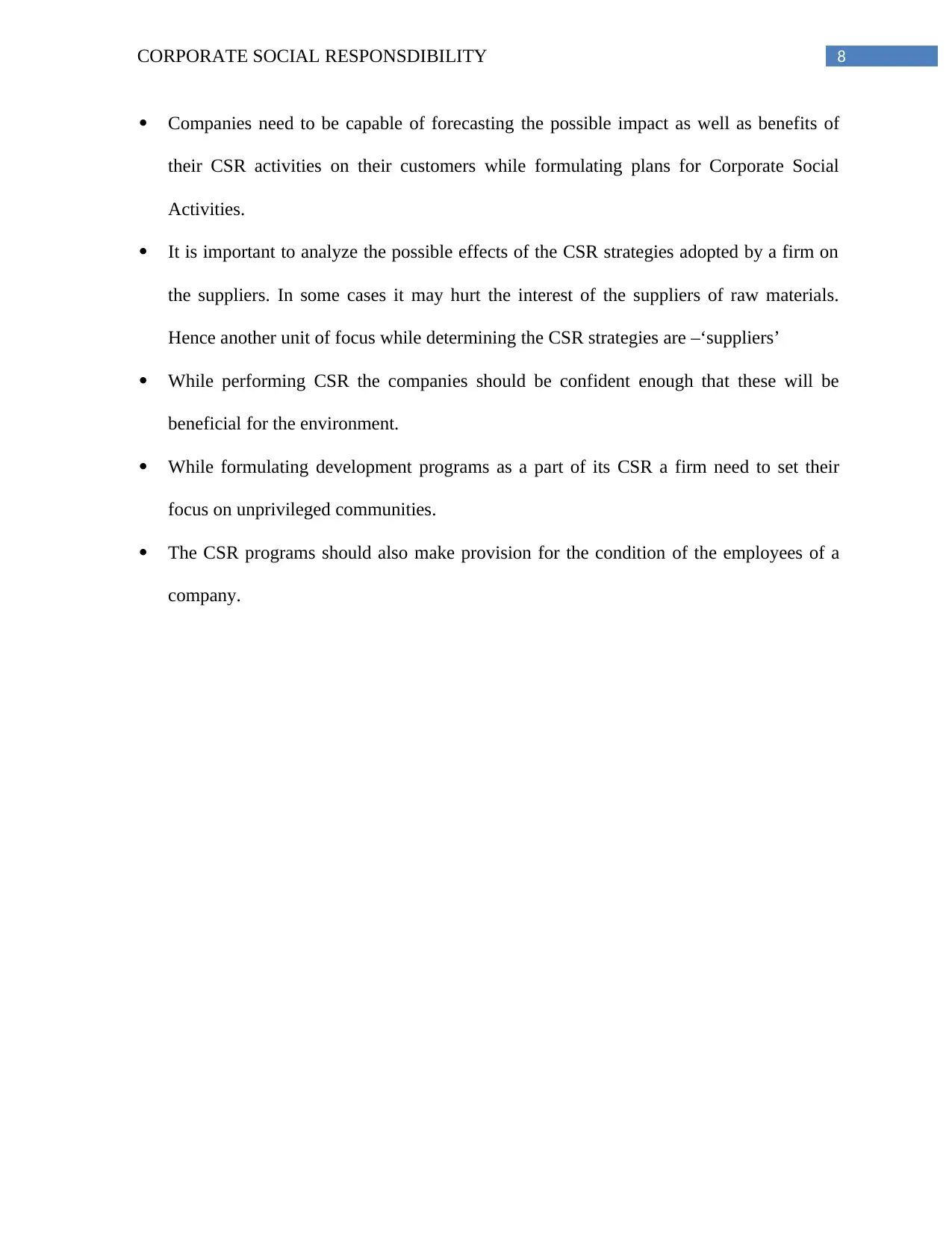
8CORPORATE SOCIAL RESPONSDIBILITY
Companies need to be capable of forecasting the possible impact as well as benefits of
their CSR activities on their customers while formulating plans for Corporate Social
Activities.
It is important to analyze the possible effects of the CSR strategies adopted by a firm on
the suppliers. In some cases it may hurt the interest of the suppliers of raw materials.
Hence another unit of focus while determining the CSR strategies are –‘suppliers’
While performing CSR the companies should be confident enough that these will be
beneficial for the environment.
While formulating development programs as a part of its CSR a firm need to set their
focus on unprivileged communities.
The CSR programs should also make provision for the condition of the employees of a
company.
Companies need to be capable of forecasting the possible impact as well as benefits of
their CSR activities on their customers while formulating plans for Corporate Social
Activities.
It is important to analyze the possible effects of the CSR strategies adopted by a firm on
the suppliers. In some cases it may hurt the interest of the suppliers of raw materials.
Hence another unit of focus while determining the CSR strategies are –‘suppliers’
While performing CSR the companies should be confident enough that these will be
beneficial for the environment.
While formulating development programs as a part of its CSR a firm need to set their
focus on unprivileged communities.
The CSR programs should also make provision for the condition of the employees of a
company.
⊘ This is a preview!⊘
Do you want full access?
Subscribe today to unlock all pages.

Trusted by 1+ million students worldwide
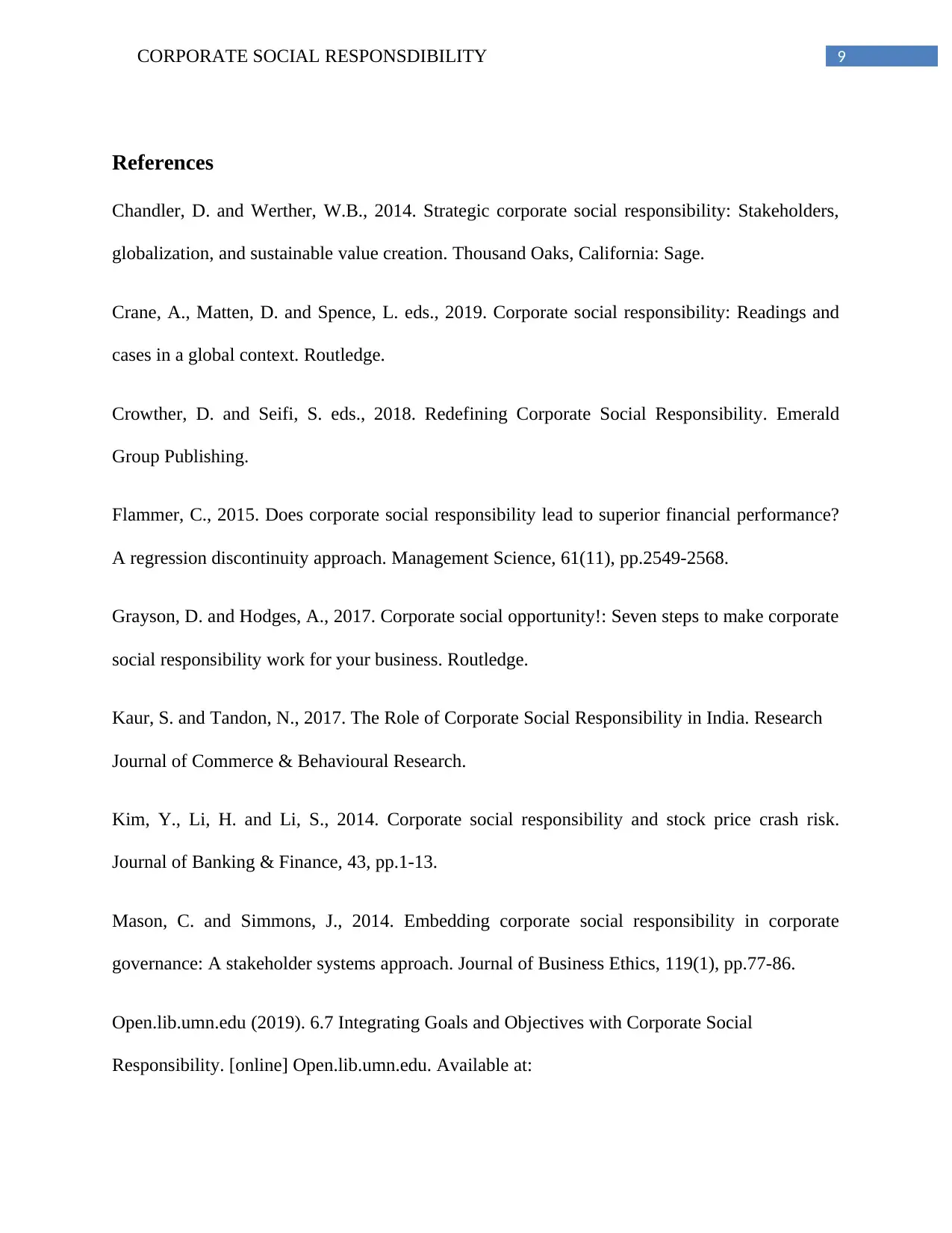
9CORPORATE SOCIAL RESPONSDIBILITY
References
Chandler, D. and Werther, W.B., 2014. Strategic corporate social responsibility: Stakeholders,
globalization, and sustainable value creation. Thousand Oaks, California: Sage.
Crane, A., Matten, D. and Spence, L. eds., 2019. Corporate social responsibility: Readings and
cases in a global context. Routledge.
Crowther, D. and Seifi, S. eds., 2018. Redefining Corporate Social Responsibility. Emerald
Group Publishing.
Flammer, C., 2015. Does corporate social responsibility lead to superior financial performance?
A regression discontinuity approach. Management Science, 61(11), pp.2549-2568.
Grayson, D. and Hodges, A., 2017. Corporate social opportunity!: Seven steps to make corporate
social responsibility work for your business. Routledge.
Kaur, S. and Tandon, N., 2017. The Role of Corporate Social Responsibility in India. Research
Journal of Commerce & Behavioural Research.
Kim, Y., Li, H. and Li, S., 2014. Corporate social responsibility and stock price crash risk.
Journal of Banking & Finance, 43, pp.1-13.
Mason, C. and Simmons, J., 2014. Embedding corporate social responsibility in corporate
governance: A stakeholder systems approach. Journal of Business Ethics, 119(1), pp.77-86.
Open.lib.umn.edu (2019). 6.7 Integrating Goals and Objectives with Corporate Social
Responsibility. [online] Open.lib.umn.edu. Available at:
References
Chandler, D. and Werther, W.B., 2014. Strategic corporate social responsibility: Stakeholders,
globalization, and sustainable value creation. Thousand Oaks, California: Sage.
Crane, A., Matten, D. and Spence, L. eds., 2019. Corporate social responsibility: Readings and
cases in a global context. Routledge.
Crowther, D. and Seifi, S. eds., 2018. Redefining Corporate Social Responsibility. Emerald
Group Publishing.
Flammer, C., 2015. Does corporate social responsibility lead to superior financial performance?
A regression discontinuity approach. Management Science, 61(11), pp.2549-2568.
Grayson, D. and Hodges, A., 2017. Corporate social opportunity!: Seven steps to make corporate
social responsibility work for your business. Routledge.
Kaur, S. and Tandon, N., 2017. The Role of Corporate Social Responsibility in India. Research
Journal of Commerce & Behavioural Research.
Kim, Y., Li, H. and Li, S., 2014. Corporate social responsibility and stock price crash risk.
Journal of Banking & Finance, 43, pp.1-13.
Mason, C. and Simmons, J., 2014. Embedding corporate social responsibility in corporate
governance: A stakeholder systems approach. Journal of Business Ethics, 119(1), pp.77-86.
Open.lib.umn.edu (2019). 6.7 Integrating Goals and Objectives with Corporate Social
Responsibility. [online] Open.lib.umn.edu. Available at:
Paraphrase This Document
Need a fresh take? Get an instant paraphrase of this document with our AI Paraphraser
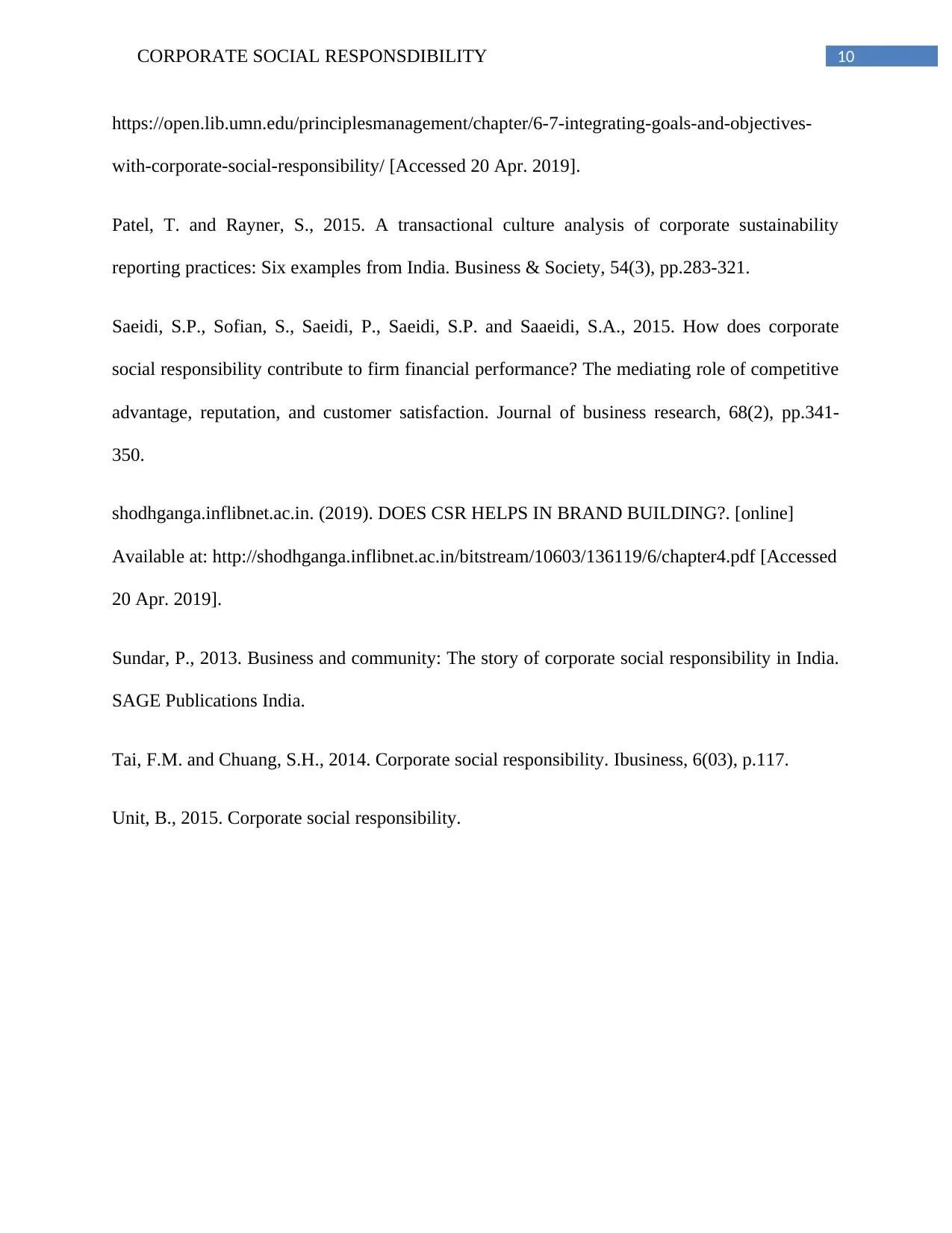
10CORPORATE SOCIAL RESPONSDIBILITY
https://open.lib.umn.edu/principlesmanagement/chapter/6-7-integrating-goals-and-objectives-
with-corporate-social-responsibility/ [Accessed 20 Apr. 2019].
Patel, T. and Rayner, S., 2015. A transactional culture analysis of corporate sustainability
reporting practices: Six examples from India. Business & Society, 54(3), pp.283-321.
Saeidi, S.P., Sofian, S., Saeidi, P., Saeidi, S.P. and Saaeidi, S.A., 2015. How does corporate
social responsibility contribute to firm financial performance? The mediating role of competitive
advantage, reputation, and customer satisfaction. Journal of business research, 68(2), pp.341-
350.
shodhganga.inflibnet.ac.in. (2019). DOES CSR HELPS IN BRAND BUILDING?. [online]
Available at: http://shodhganga.inflibnet.ac.in/bitstream/10603/136119/6/chapter4.pdf [Accessed
20 Apr. 2019].
Sundar, P., 2013. Business and community: The story of corporate social responsibility in India.
SAGE Publications India.
Tai, F.M. and Chuang, S.H., 2014. Corporate social responsibility. Ibusiness, 6(03), p.117.
Unit, B., 2015. Corporate social responsibility.
https://open.lib.umn.edu/principlesmanagement/chapter/6-7-integrating-goals-and-objectives-
with-corporate-social-responsibility/ [Accessed 20 Apr. 2019].
Patel, T. and Rayner, S., 2015. A transactional culture analysis of corporate sustainability
reporting practices: Six examples from India. Business & Society, 54(3), pp.283-321.
Saeidi, S.P., Sofian, S., Saeidi, P., Saeidi, S.P. and Saaeidi, S.A., 2015. How does corporate
social responsibility contribute to firm financial performance? The mediating role of competitive
advantage, reputation, and customer satisfaction. Journal of business research, 68(2), pp.341-
350.
shodhganga.inflibnet.ac.in. (2019). DOES CSR HELPS IN BRAND BUILDING?. [online]
Available at: http://shodhganga.inflibnet.ac.in/bitstream/10603/136119/6/chapter4.pdf [Accessed
20 Apr. 2019].
Sundar, P., 2013. Business and community: The story of corporate social responsibility in India.
SAGE Publications India.
Tai, F.M. and Chuang, S.H., 2014. Corporate social responsibility. Ibusiness, 6(03), p.117.
Unit, B., 2015. Corporate social responsibility.
1 out of 11
Related Documents
Your All-in-One AI-Powered Toolkit for Academic Success.
+13062052269
info@desklib.com
Available 24*7 on WhatsApp / Email
![[object Object]](/_next/static/media/star-bottom.7253800d.svg)
Unlock your academic potential
Copyright © 2020–2025 A2Z Services. All Rights Reserved. Developed and managed by ZUCOL.





